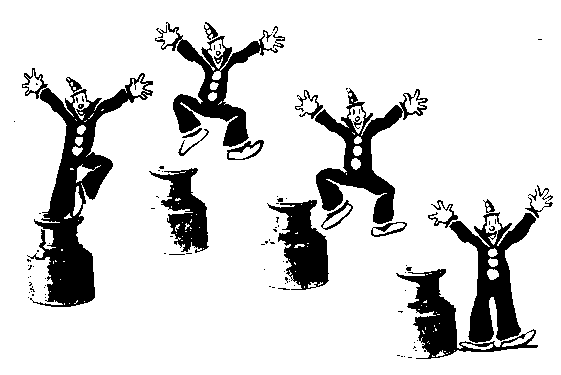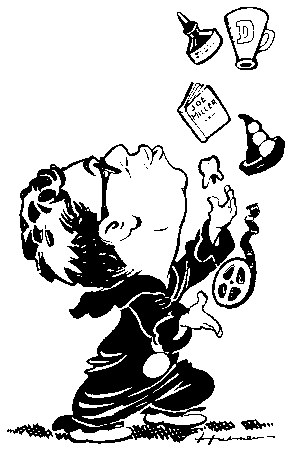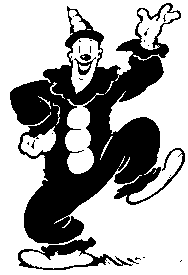|



              
 |
Contents
•
WARD KIMBALL's introduction at the 1978 Annie Awards (Anim.
P. 1)
•
GRIM NATWICK's Memoria (Animation
Page 2)
•
DICK HUEMER's recollections about his career (Animation
Page
3)
•
JOE ADAMSON's interview concerning the Fleischers (this page)
•
FILMOGRAPHY from Disney's (Animation Page 5)
•
OBITUARY from Daily Variety (Animation
Page 6)
Working
for the Fleischers
An
Interview with Dick Huemer
by
Joe Adamson
(recorded
in 1968-1969 for the AFI/UCLA program)
|
Dick
Huemer made his deepest mark on
animated
cartoons in the late Thirties
and
early Forties, when he was story
director
for such Walt Disney features
as
Fantasia and Dumbo. Dumbo in par-
ticular
owes a great deal to Huemer and
Joe
Grant, who shared story direction
with
him on many Disney projects.
But
Huemer had already seen--and made
--a
lot of animation history before he
joined
the Disney studio. He started in
animation
in 1916, animating Mutt and
Jeff
cartoons for Raoul Barre, and
worked
for Max and Dave Fleischer off
and
on during the Twenties. Later, he
directed
cartoons for Charles Mintz,
before
joining Disney's staff. With Dis-
ney,
he animated on many cartoons
before
becoming a director of shorts (he
directed
the first cartoon in which
Goofy
starred, Goofy and Wilbur) and
then
a story director on features.
Joe
Adamson recorded six interviews
with
Huemer in 1968 and 1969, as part |
of
the American Film Institute/Universi-
ty
of California at Los Angeles Oral
History
program. The interview that
follows
is an excerpt from that Oral
History,
heavily edited and with addi-
tions
by Huemer. In this excerpt,
Huemer
discusses his work in the
Twenties
and early Thirties, when he
was
associated first with the Fleischers
and
then with Charles Mintz.
Another
excerpt from the Oral Histo-
ry,
dealing with Huemer's earliest
work
in animation, was published in
the
summer 1974 issue of AFI Report,
the
magazine of the American Film In-
stitute.
Copies can be ordered for $1.50
from
AFI, Kennedy Center, Washing-
ton,
D.C. 20566.
Joe
Adamson is the author of a cur-
rent
book on the Marx brothers
(Groucho,
Harpo, Chico and Sometimes
Zeppo)
and a forthcoming book on Tex
Avery,
as well as being a prize-winning
filmmaker
(Political Cartoon). |
|
 |
Source:
Theatre Organ Bombarde
11(5):6-7,
October 1969 |
Adamson:
When did you start work-
ing for the Fleischers?
Huemer:
Around 1923.
Adamson:
Is this after Mutt and Jeff?
Huemer:
Yes. But I must have had
other jobs.
After all, I was still an artist.
I could
decorate lampshades, do com-
mercial art.
When I
came to work for the
Fleischers,
Doc Crandall was their only
animator. He
used to do the rotoscope,
as well as
other bits of animation.
Adamson:
There were only two of
you, then,
when you started with
Fleischer?
Huemer: No,
Burt Gillett had gotten
there just
before me, and he got me in.
He had been
sort of a shop foreman at
Mutt and Jeff.
He was head man for a
while, ran the
place. When it changed
hands, after
both Barre and Bowers
were out,
Gillett ran it for the Jefferson
Film
Corporation. So when he left that
place he went
to the Fleischers, then he
got me in
there. It was a very small
staff. I don't
think there were more than
about six
people on the staff.
Adamson:
The whole thing? Includ-
ing inkers and
painters and camera-
men?
Huemer:
Yes. Something like that.
Say ten at the most.
Adamson:
Not even as big as Barre's
place, then.
Huemer: No,
it was very small, a very
cozy cluttered
little place. They were
on the
basement floor of an old
brownstone
building on 45th Street
right off
Lexington Avenue.
Adamson:
They were more or less
leading the
field at the time, weren't
they?
Huemer:
No, Terry was already doing
well. But
actually he was the only one
we considered
serious competition and
perhaps as
having a slight edge on
everybody else.
The
Fleischers were doing Out of the
Inkwell. Koko
the Clown and Max were
the main
characters. Then we in-
troduced other
characters as pro-
tagonists. For
example, once we took
Koko to Mars,
and he had Martians to
contend with.
Those Inkwells were ac-
tually quite
good cartoons, I still
believe. They
were definitely to my
mind a step
above the Mutt and Jeffs
They had
better stories for one thing.
Adamson: Were
the animators still
making up
their own gags, or did you
have a little
bit more supervision?
Huemer:
As I recall, I would work
with Dave
Fleischer. Max, of course,
acted in all
the pictures and had overall
say in
production. His brother Dave was
more or less
the director of the cartoon
operation.
We'd get together and talk
about what to
animate. The studio, you
see, was so
small that you could walk
from desk to
desk. Not like the Disney
studio became,
full of rooms, and where
nobody ever
sees anybody or talks to
anybody. Then,
I could yell across the
room,
"Hey, Dave. I want to talk to you.
Suppose we do
this." And then we'd sit
down and talk
it over and laugh our
heads off at
our great gags, and then it
would be my
job to animate what we
had threshed
out. But, of course, we al-
ways had a
basic theme. Generally
quite clever.
Did you ever see the one
about the fly?
That's the surviving Ink-
well that you
see around a lot. A fly is
bothering Max;
gags, complications, et
cetera, et
cetera. Take it from there. All
in all, it was
very relaxed working with
the Fleischers.
There
was a funny non-productive
incident that
started when I drew great
big teeth on
Koko, something the
Fleischers
never had done up to that
time. Well,
Dave started kidding me
about it,
baring his teeth at me every
time I looked
at him. Or he would draw
an enormous
tooth on my drawing
paper when my
back was turned. Then
finally one
night on my way home, I put
my hand into
my pocket and fished out
a handful of
teeth. Human ones. He'd
gotten them
from a dentist friend of his.
I forget what
my next move was -- pro-
bably slipping
one or two into his
dessert at
lunch, or some other disgust-
ing thing. And
then came the morning
when I raised
my drawing board to
switch on the
light and my hand
touched
something slimy. There,
draped over
the light bulb, was the
lower half of
a cow's jaw, replete with
great big
yellow teeth and shreds of
unhealthy-looking
flesh. Naturally I
couldn't let
him quit while he was
ahead. So I
sneaked down to the street
when he wasn't
looking and placed the
cadaver on the
motor of his Ford. I was
only sorry I
wasn't there when he
started to
smell roast beef on his way
home. That
kind of ended the whole rib.
Neither of us
could find a topper after
that. Although
30 years later, when I
met Dave
accidentally in a theatre lob-
by, the first
thing he did was to make
big teeth at
me and look distressed.
|
 |
Dave Fleischer
by RMH |
. |
Adamson: How big a part did Max
play
in these cartoons?
Huemer: He would always open the
picture,
then in some trick manner the
clown
would come out of the inkwell.
Max
would take the cork off the ink-
well,
or other cleverer ways, then
Koko'd
be loose, and he'd play against
Max.
He'd squirt ink at him, whatever
the
gags were. Then in the end he al-
ways
dove back into the inkwell, and
Max
put the cork back on. A sort of cir-
cular
effect, to complete the thing.
Adamson:
What function did Max
have
in the creation of the cartoons?
Huemer:
He had been the one to
create
the Inkwell series while he was
with
Bray. He even animated the early
ones.
Later on, he didn't mix in much in
the
cartoon production. I think brother
Dave
carried that on for the most part.
Nevertheless,
Max was there to render
final
opinions and decisions and as
president
to run the company. After all,
it
had grown and he always had ideas
on
expansion. He formed live-action
companies.
He bought French films.
And
he started Red Seal Film Corpora-
tion
to release this product. For a while
he
was doing, unsuccessfully I'm afraid,
what
Disney finally did very suc-
cessfully
-- releasing his own product.
His
wasn't successful for the reason
that
in establishing and maintaining
these
releasing agencies and booking
offices,
he paid out more than he took in
from
the films. Anyway, it just didn't
work
out. That's the story as I under-
stand
it.
Adamson:
He spent most of his time
in
the front office and as an actor.
Huemer:
I never saw him much in the
drawing
rooms. I mean actively partici-
pating.
Dave took over that chore. Dave
handled
it. And very well. It was fun
working
with Dave.
Adamson: When you say it was fun,
do
you mean ...
Huemer: Dave had good ideas. We
laughed
a lot, and said, "Hey, that's fun-
ny!"
Or, "Great! Why don't we do that."
I
guess that's how the business of car-
toon
creation is carried on.
Adamson: What would you say was
the
major reason for these cartoons
being
better than the others?
Huemer: They had more interesting
ideas,
for one thing. They had live ac-
tion,
which is instantly understandable
to
an audience, right away. There was
Max,
a live person whom they got to
like
after a while. Max was not a great
actor
or comedian, but at least, if you
saw
a few of his pictures, you got to
know
him, and you were sympathetic
to
his troubles. Another thing the
Fleischers
did was something they
called
rotoscope. Max used that right
from
the very start. Dave Fleischer
would
put on a clown suit, and they
would
photograph him in some wild ac-
tion.
And then they would take those
films
and project them and draw over
them.
A simple enough process, but it
gave
astonishingly lifelike action.
That
would be only one little scene in
each
of the shorts. It was apparently too
expensive
to use more often. All the ac-
tion
had to be first shot, photographed,
and
projected, and then somebody
would
have to draw each frame. That is
to
say, somebody would have to change
it
to cartoon form, and somebody had to
ink
and fill in the blacks. All so that
when
completed it didn't look too
different
from the animation that was
hand-drawn
and not based on human
photography.
Adamson: Did you do any of it?
Huemer: No, I never did any of it.
That
was purely mechanical. You only
had
to follow what was on the film.
Incidentally,
McCay's animation was
very
lifelike, too, in some of his early
cartoons,
which was an amazing thing,
because
he didn't have rotoscope. He
didn't
base any of it on actual live ac-
tion.
He did a little cartoon about Nemo,
which
was very natural, some really
very
beautiful lifelike animation and
draftsmanship.
It's surprising, because
he
did that so long before anybody else.
And
then in between his time and when
Disney
came along, there was a lot of
raunchy-looking
stuff -- not good
drawing
or action either. McCay hit a
high
peak at the very start, after which
quality
went down and then surfaced
again
when Disney entered the picture.
Adamson: Winsor McCay didn't use
the
in-between'system, did he? He
would
go straight from one drawing to
the
next.
Huemer: That's right. We found that
out at a
banquet we gave in 1928. It was
the first
Animators' Banquet, and he
was the guest
of honor.
Adamson:
You didn't do this every
year, did you?
Huemer:
No, we were sort of dis-
couraged,
especially because after we
were through
the owner of the hotel
said,
"'Raus! -- and don't come back!"
The last
impression I have of the night
of the brawl
was somebody trying to
high-kick the
crystal chandelier. Any-
way, during
the after-dinner speaking
McCay got up.
He had a few under his
belt, as we
all did -- there were only
about 30 of
us, that's about all there
were in the
business, in those days.
NEXT
PAGE» |


![]()
![]()
![]()
![]()
![]()
![]()
![]()
![]()
![]()
![]()
![]()
![]()
![]()
![]()
![]()
![]()
![]()

